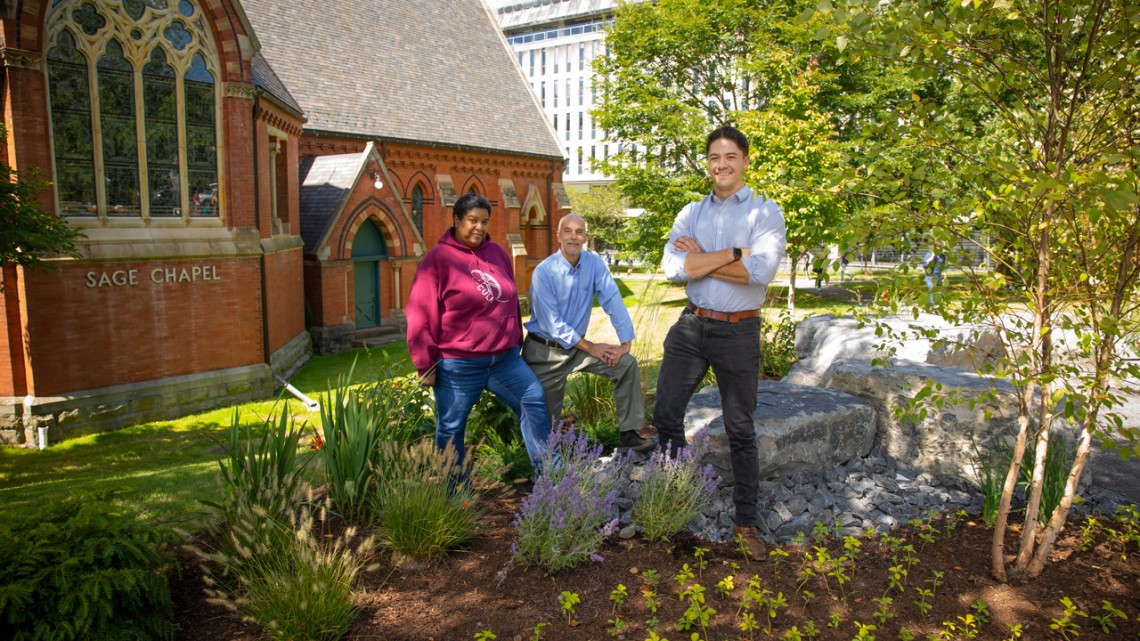
From left, Valerie Aymer, associate professor of practice in the Department of Landscape Architecture, David Cutter, university landscape architect, and William Gossett ’19 stand at the new 1967 fire memorial.
Student, landscape architects create 1967 fire memorial
By Krishna Ramanujan
A new memorial in the center of campus, created this summer and designed by a landscape architect student, serves as a contemplative reminder of eight students and a professor who died in a tragic fire in 1967 at the off-campus Cornell Heights Residential Club.
The fire memorial between Sage Chapel and Day Hall was dedicated at a ceremony Oct. 4, attended by fire survivors, victims’ family, friends and university officials, among others. Inspired by the calm and natural serenity of nearby Wee Stinky Glen, the design features nine local limestone boulders – one for each victim – procured by members of the university’s grounds crew from around campus and Beebe Lake, and a bronze plaque inlaid into one stone. They also planted river birch to blend with trees surrounding Sage Chapel, shrubs and spring flower bulbs.
“This memorial and its surroundings were conceived with great care and with attention to the location in mind,” said Joel Malina, vice president for university relations, who led the ceremony. “This spot was selected for its proximity to Sage Chapel, a quiet place for contemplation amid the hustle and bustle of central campus.”
The chapel also was where a memorial service for the fire victims was held in April 1967, he said.
When the idea for the memorial was proposed last spring, University Architect Margaret Carney consulted the university’s master plan to determine a central and permanent location. At the same time, David Cutter, university landscape architect, suggested the design of the memorial was a perfect opportunity to engage students in the project, Carney said.
Cutter recruited Valerie Aymer, associate professor of practice in the Department of Landscape Architecture, who created a one-credit independent study and sent an email to all the students in the department.
Four students answered the call and created initial designs: three master’s students in landscape architecture – Elijah Ball, Onam Bisht and Lyuxiao Liu – and William Gossett ’19, currently a project designer for a landscape architecture firm in Connecticut. The students were given background about the fire victims and details of the fire itself.
“Part of the reasoning behind some of the items that were chosen for the site, and for the actual memorial, was based on how we can express the loss of these students in the prime of their lives,” Aymer said.
After initial designs were drawn, the students consulted with Aymer, Cutter and Carney and reworked their ideas. When the final designs were ready, they were reviewed by a committee of alumni survivors and victims’ friends and relatives. “The committee wanted the memory of those who died to not be lost but be preserved in a dignified and peaceful way,” Carney said. They felt Gossett’s design best represented the spirit of the memorial, Carney said.
“I wanted to create a memorial that not only worked with the context of the surrounding landscape, but also was iconic in its own way,” Gossett said. He felt the natural edges of the boulders, near the brick chapel, within the open green space, created a timeless quality, “something that will be able to survive for generations” and not become dated, he said.
Media Contact
Get Cornell news delivered right to your inbox.
Subscribe
